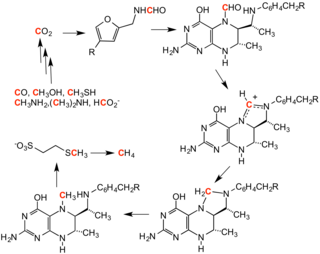Pterin

| |
| Names | |
|---|---|
| IUPAC names
2-Aminopteridin-4(3H)-one
(one of many tautomers; see text) | |
| Other names
Pteridoxamine
Pterine 4-Oxopterin 2-Amino-4-pteridone 2-Amino-4-hydroxypteridine 2-Amino-4-oxopteridine 2-aminopteridin-4-ol 2-Amino-4-pteridinol | |
| Identifiers | |
3D model (
JSmol ) |
|
| ChEBI | |
| ChEMBL | |
| ChemSpider | |
ECHA InfoCard
|
100.017.091 |
PubChem CID
|
|
| UNII | |
CompTox Dashboard (EPA)
|
|
| |
| |
| Properties | |
| C6H5N5O | |
| Molar mass | 163.137 |
Except where otherwise noted, data are given for materials in their standard state (at 25 °C [77 °F], 100 kPa).
| |
Pterin is a
Pterins were first discovered in the pigments of butterfly wings[1] (hence the origin of their name, from the Greek pteron (πτερόν),[2] wing) and perform many roles in coloration in the biological world.
Chemistry
Pterins exhibit a wide range of
The pteridine ring system contains four nitrogen atoms, reducing its aromaticity to the point that it can be attacked by nucleophile. Pterins can take three oxidation states on the ring system: the unprefixed oxidized form, the 7,8-dihydro semi-reduced form (among other, less stable tautomers), and finally the 5,6,7,8-tetrahydro fully-reduced form. The latter two are more common in biological systems.[5]
Biosynthesis
Pterin rings are either salvaged from existing ones or produced de novo in living organisms. The ring comes from rearrangement of guanosine in bacteria[6] and humans.[7]

Pterin cofactors
Pterin derivatives are common cofactors in all domains of life.
Folates
One important family of pterin derivatives are
Substituted
Molybdopterin

Molybdopterin biosynthesis does not use the conventional GTPCH-1 pathway. It occurs in four steps:[10]
- the radical-mediated cyclization of nucleotide, guanosine 5′-triphosphate (GTP), to (8S)‑3′,8‐cyclo‑7,8‑dihydroguanosine 5′-triphosphate (3′,8‑cH2GTP),
- the formation of cyclic pyranopterin monophosphate (cPMP) from the 3′,8‑cH2GTP,
- the conversion of cPMP into molybdopterin (MPT),
- the insertion of molybdate into MPT to form Moco (molybdenum cofactor).
Tetrahydrobiopterin
Tetrahydrobiopterin, the major unconjugated pterin in vertebrates, is involved in three families of enzymes that effect hydroxylation. The aromatic amino acid hydroxylases include phenylalanine hydroxylase, tyrosine hydroxylase, and tryptophan hydroxylases. They are involved in the synthesis of neurotransmitters catecholamine and serotonin. Tetrahydrobiopterin is also required for the functioning of alkylglycerol monooxygenase, whereby monoalkylglycerols are broken down to glycerol and an aldehyde. In the synthesis of nitric oxide the pterin-dependent nitric oxide synthase converts arginine to its N-hydroxy derivative, which in turn releases nitric oxide.[12]
Other pterins

Tetrahydromethanopterin is a cofactor in methanogenesis, which is a metabolism adopted by many organisms, as a form of anaerobic respiration.[13] It carries the C1 substrate in the course of the formation or production of methane. It is structurally similar to folate.
Pterin pigments

Cyanopterin is a glycosylated derivative of pteridine, having an unknown function in cyanobacteria.[15]
See also
References
External links
- Thomas AH. "Photochemistry and Reactivity of Pteridines Research Group". La Plata, Argentina: Universidad Nacional De La Plata.
